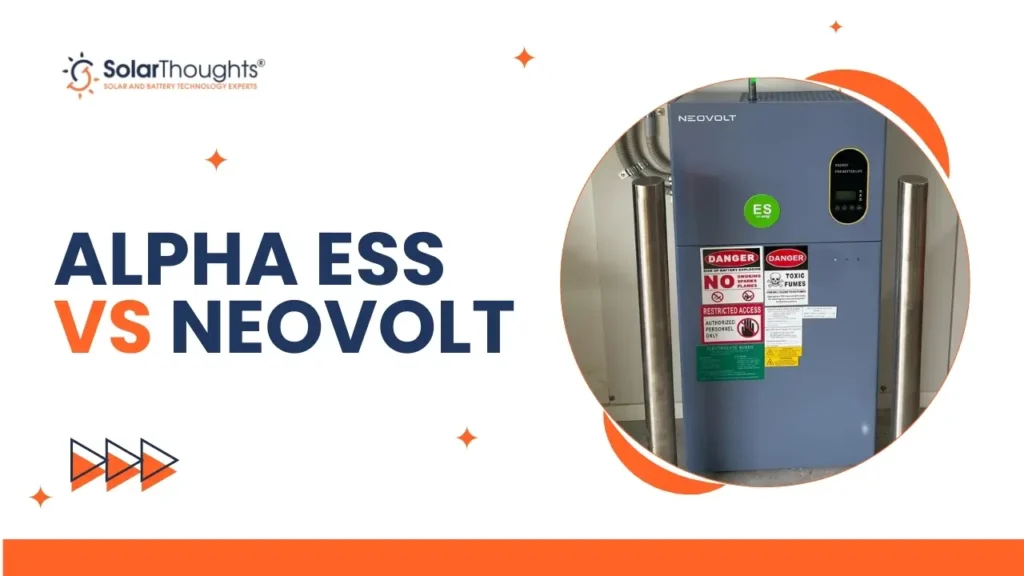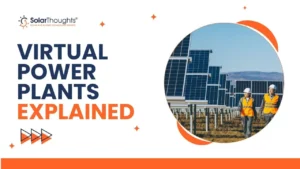The choice between an Alpha ESS battery and a Neovolt battery could save homeowners thousands of dollars throughout their lifetime. Both systems showcase impressive specifications – Alpha ESS with its 96% round-trip efficiency and Neovolt with its 8000 charge cycles. The original investment differs a lot. A 10 kWh Alpha ESS system ranges from AUD 12,000 to 15,000, but Neovolt provides the same capacity at AUD 8,000 to 10,000.
Table of Contents
ToggleBrisbane’s move toward solar energy storage and rising electricity costs make battery system selection a vital decision today. Each brand brings distinct advantages. Alpha ESS comes with a complete 10-year warranty that maintains 80% capacity retention. Neovolt guarantees over a decade of performance with proper maintenance. This detailed comparison will help you determine which battery system gives better value for your money in 2025.
Alpha ESS vs Neovolt: Key Specifications Compared
The technical specs of these two battery systems show clear differences that affect how they work in ground situations. Alpha ESS and Neovolt both employ advanced technology, but their energy storage approaches offer unique benefits based on what your house needs.
Battery Chemistry and Technology
These manufacturers picked lithium iron phosphate (LiFePO4) chemistry for their battery systems, which many experts call the safest type of lithium-ion technology. This chemistry gives better thermal stability than other lithium-ion variants, making it perfect for home installations.
Alpha ESS gets its battery modules from EVE, a Chinese company with 20+ years of battery manufacturing experience. Their modules deliver high performance with longer cycle life and quick charge/discharge abilities.
Neovolt’s LiFePO4 batteries shine in durability and longevity. These batteries last about 5,000 cycles at 80% capacity. Some reports suggest Neovolt systems might reach 8,000 cycles, though your usage and environment could change this number.
Storage Capacity and Usable Energy
Alpha ESS’s SMILE series comes with flexible capacity options. Their SMILE-M5 lets you expand storage from 5 kWh to 20 kWh with 100% depth of discharge (DoD). Home installations can range from 3 kW to 20 kW.
Neovolt offers a 10.1 kWh battery that gives you 9.6 kWh of usable capacity – that’s 95% depth of discharge. You can connect up to six units of this single-phase, all-in-one system in parallel, so you can scale up as your energy needs grow.
Alpha ESS built their systems to be modular. Homeowners can start small and add more capacity later. Their SMILE-G3-BAT-10.1P fits modern homes with its high capacity in a modular format.
Power Output and Surge Capabilities
Alpha ESS SMILE-M5 puts out 5000W nominal power and can handle peak loads up to 200%. This extra surge power keeps things running smoothly when multiple appliances kick in at once.
Neovolt gives you two inverter choices:
- 3.6kW model (BW-INV-SPH3.6K)
- 5kW model (BW-INV-SPH5K)
Neovolt systems back you up with either 7.36kW or 10kW surge power, depending on your inverter choice. This strong surge ability makes Neovolt great for homes that need more instant power during outages.
Both systems protect you during blackouts, with Alpha ESS highlighting this feature in their SMILE5 series. Your vital circuits stay powered when the grid fails – a vital feature if your area’s power supply isn’t reliable.
Read More On Neovolt Battery Review 2025
Efficiency Ratings and Performance Metrics
Efficiency determines how much stored energy you actually get to use. Alpha ESS achieves round-trip efficiency up to 96%, ranking among the best in home batteries. Round-trip efficiency shows how much energy you get back compared to what you put in, counting all system losses.
Neovolt’s systems match up well with:
- Battery efficiency (AC to BAT): 97.3%
- System efficiency (PV to Battery Load): 97%
- Overall round-trip efficiency: Over 90%
Alpha ESS typically uses DC-coupled setups, which give better round-trip efficiency than AC-coupled systems because they need fewer energy conversions. This efficiency boost helps save more energy throughout the system’s life.
Both systems come with IP65 ingress protection ratings, so you can install them inside or outside in different environments.
Upfront Investment Analysis
Home battery systems from Alpha ESS and Neovolt come with different price tags, and upfront costs are just the beginning. Your long-term returns depend a lot on government incentives and financing options.
Purchase and Installation Costs
A typical Alpha ESS 10kW battery system in Sydney costs between AUD 12,000 to AUD 15,000 with installation. The 5-10kW Alpha ESS batteries range from AUD 12,996.42 to AUD 15,289.90. Installation costs add quite a bit to these prices. A simple setup adds at least AUD 2,293.49 to your quote. Complex installations need longer cable runs, protective bollards, or fireproof backing and can cost AUD 4,586.97 or more.
The Smile 5 13.3 kWh model from Alpha ESS is a budget-friendly choice at AUD 16,818.89 fully installed. Neovolt sits in the mid-range market and balances performance with cost-effectively. You’ll pay between AUD 1,528.99 to AUD 1,834.79 per kWh for residential solar batteries.
Available Rebates and Incentives
Government rebates help cut down your upfront costs. The NSW Government’s home battery rebate program takes AUD 244.64 to AUD 366.96 off your initial investment. On top of that, joining a Virtual Power Plant (VPP) gives you an extra AUD 382.25 to AUD 611.60, which you can claim twice over three years.
The federal government might soon offer up to AUD 993.84 per household through a proposed national scheme. They’ve also announced a AUD 3.52 billion national battery rebate program that should cut battery costs by 30%. Western Australia leads with the most generous support, up to AUD 11,467.43 through their Residential Battery Rebate Scheme.
Financing Options and Payback Period
Many paths exist to manage your upfront costs. Solar installers across Australia offer zero-dollar upfront deals for Alpha ESS systems. Banks provide green loans with lower interest rates for eco-friendly projects. Solar leasing lets you rent battery systems with fixed monthly payments instead of buying them outright. Buy Now, Pay Later plans let you install now and pay later.
Alpha ESS batteries usually pay for themselves in about 7.2 years. This is outside their 5-year product warranty but still within the 10-year performance warranty period. Solar-battery combinations work out better financially, with payback periods around 5.6 years. Current energy prices mean subsidized batteries give better long-term returns than most major investments.
Long-Term Savings Potential
The true value of battery systems shows up after years of operation. Small differences in performance can save or cost thousands of dollars beyond the original purchase price.
Energy Bill Reduction Calculations
Both systems boost energy independence by increasing self-consumption of solar power. Without batteries, households typically cover only 30-50% of their power needs from solar. Battery storage pushes this up to 80-90% or maybe even 100%. Note that this huge drop in grid dependency leads to lower electricity bills.
You must account for lost solar feed-in tariff revenue when calculating potential savings. Alpha ESS users have found extra benefits beyond direct savings. Their AlphaCloud monitoring platform helps spot consumption patterns that lead to better energy optimization and lower usage.
Warranty Coverage and Replacement Costs
Alpha ESS offers a detailed 10-year warranty for their battery systems. This guarantees they’ll keep at least 70% of original capacity throughout this period. Neovolt batteries are a match for this with a 5-year product warranty plus a 10-year performance warranty, ensuring at least 80% capacity retention.
Current market analysis shows most residential batteries take longer to pay back than their warranted lives, even with VPP benefits. Battery prices would need to drop to AUD 305-458 per kWh to achieve good financial returns. This is a big deal as it means that current rates sit at approximately AUD 1,529 per kWh.
Expected Lifespan and Degradation Rates
Both manufacturers use lithium iron phosphate (LFP) chemistry, known for exceptional longevity:
- Alpha ESS batteries degrade about 2% yearly due to their advanced battery management system
- Neovolt batteries promise 5,000-8,000 charge cycles. This could extend usable life to 15-20 years under optimal conditions
The actual lifespan depends on discharge patterns, temperature management, and charging cycles. Batteries reach end-of-life when capacity drops below 60-70% of original levels. You can extend useful life beyond warranty periods by keeping shallower discharges (staying within 20-80% charge range) and avoiding temperature extremes.
ROI Comparison for Different Households
Battery investment returns can vary a lot based on how much energy a household uses. A closer look at Alpha ESS and Neovolt shows some unexpected differences in how long it takes to get your money back.
Small Homes (Under 15kWh Daily Usage)
Small households face some unique money challenges when it comes to batteries. Young adults or older families who use about 20 kWh each day get the best results from a 5 kW solar system with a smaller 3.5 kWh battery. Neovolt’s lower upfront cost makes it a great choice for budget-conscious buyers.
Alpha ESS shines when it comes to growing your system later. The catch is that homes with steady, low power use might not tap into the full capacity, which means it takes longer to break even.
Both systems work reliably for users. Alpha ESS customers say their systems keep them 98% self-sufficient. Small homes get the best returns when they use smart energy features to move their power use to daylight hours, which might mean they need less battery storage.
Medium Homes (15- 30 kWh Daily Usage)
Most installations happen in medium-sized homes that use about 30kWh daily throughout the day. These homes work best with a 6.6kW solar system and a 6.5kWh battery solution.
The numbers show medium homes can save around AUD 2,140 yearly with a mid-sized 10kW battery system, breaking even in 10 years. Neovolt’s warranty covers this entire period, making it a perfect match for average family homes.
Alpha ESS users in this group see great real-life results. Their daily power bills run from just AUD 0.55 to AUD 1.68, depending on the weather. Some families have even built up over AUD 30 in credit with their power companies by managing their Alpha ESS systems well.
Large Homes (Over 30 kWh Daily Usage)
Homes with high power needs like swimming pools, electric water heaters, or lots of air conditioning usually need 13kW solar arrays with bigger 13.5kWh battery solutions. System efficiency becomes crucial at this size.
The data shows larger homes can reach 66% energy independence with a 6.6 kW solar system and 10 kWh battery, compared to 39% with just solar panels. These batteries charge fully on 98.5% of days, which means reliable performance.
Big energy users typically need 12 years to pay off just the battery parts, which goes beyond most standard warranties. Alpha ESS stands out between the two options because its modular design lets large homes add more storage without replacing what they already have.
Advanced Features and Future-Proofing
Battery systems need more than just economic benefits to stay relevant as the energy landscape changes faster. Alpha ESS and Neovolt systems offer features that make them valuable beyond storing energy.
Smart Energy Management Capabilities
Alpha ESS systems connect to the internet through Ethernet or Wi-Fi. This helps them get software updates and talk to AlphaCloud to monitor energy usage. The system stays up to date with new features.
Neovolt batteries use innovative technology that lets you monitor and control them through an easy-to-use app. The app shows you detailed reports about how you use energy. This helps homeowners make better decisions about their power usage.
Neovolt batteries work with SmartShift to manage energy smartly. Some Neovolt systems now use AI technology. They run Chat GPT-4 to watch how you use energy and make the system work better on its own.
Read More On Alpha ESS Battery Review 2025
Expandability and Scalability Options
The Alpha ESS SMILE-G3 battery system gives you lots of flexibility. You can connect batteries in series or parallel. Their solutions have:
- Bypass Technology: Keeps working even if one module stops working
- Intelligent Active Balancing: Moves energy between modules to keep performance steady
Neovolt batteries are adaptable too. You can start small and add more batteries later. The modular design lets you stack new battery modules without replacing old ones. You can link up to six Neovolt units together to get more power when you need it.
VPP Compatibility and Grid Services
Virtual Power Plants (VPPs) will shape the future of distributed energy. Both systems work with these networks. Neovolt batteries are VPP-ready, and homeowners can earn up to AUD 458.70 each year in VPP credits.
Alpha ESS systems help support the grid by reducing peak loads and regulating frequency. These batteries help keep the grid stable by releasing stored energy when demand is high. Owners can make extra money this way, too.
Blackout Protection Performance
Both systems protect you during power outages. Neovolt switches power in 20ms to keep selected circuits running. Solar panels can also charge Neovolt batteries during blackouts.
The Alpha ESS SMILE series protects against blackouts with “black start”. This works even if batteries run out overnight. Your critical appliances will keep working even during long power outages.
Comparison Table
| Feature | Alpha ESS | Neovolt |
| Battery Chemistry | Lithium Iron Phosphate (LiFePO4) | Lithium Iron Phosphate (LiFePO4) |
| Storage Capacity | 5-20 kWh (expandable) | 10.1 kWh (9.6 kWh usable) |
| Power Output | 5000W nominal | 3.6kW or 5kW models |
| Round-trip Efficiency | 96% | >90% |
| Original Cost (10kWh) | AUD 12,000-15,000 | AUD 8,000-10,000 |
| Warranty Period | 10-year warranty | 5-year product warranty + 10-year performance warranty |
| Capacity Retention | 70% after 10 years | 80% after 10 years |
| Cycle Life | Not mentioned | 5,000-8,000 cycles |
| Annual Degradation Rate | 2% | Not mentioned |
| Surge Capability | 200% peak overload | 7.36kW or 10kW (model dependent) |
| VPP Compatible | Yes | Yes |
| Parallel Connection | Yes (modular design) | Up to 6 units |
| IP Rating | IP65 | IP65 |
| Smart Monitoring | AlphaCloud platform | Accessible app with up-to-the-minute monitoring |
| Blackout Protection | Yes, with black start capability | Yes, 20ms switchover time |
Conclusion
Alpha ESS and Neovolt batteries give Australian homeowners great options to become energy independent. Alpha ESS shines with its 96% round-trip efficiency and complete 10-year warranty. The system costs more though, ranging from AUD 12,000 to 15,000. Neovolt provides great value at a lower price between AUD 8,000 to 10,000, and comes with impressive cycle life and smart features.
Your household size plays a big role in choosing between these systems. Small homes do well with Neovolt’s affordable pricing. Larger households might prefer Alpha ESS’s expandable design. Medium-sized homes can recover their investment with either system over 10 years, especially when you have Virtual Power Plant programs.
These systems stand out from simple storage solutions with their smart energy management features. Alpha ESS’s AlphaCloud platform tracks detailed consumption patterns. Neovolt’s AI integration optimizes energy use automatically. Both companies show steadfast dedication to future-proofing through regular software updates and VPP compatibility.
Your choice really comes down to personal needs – your budget, how you use energy, and plans for expansion. Alpha ESS works best if you want premium performance and room to grow. Neovolt makes more sense if you need reliable performance with modern features at a better price. Both systems help Australian households cut electricity costs and become energy independent.
Ready to make the smart switch?
Choose SolarThoughts – Brisbane’s trusted battery storage installer – for efficient, reliable, and future-ready solar battery solutions. Get expert advice, top-tier systems like Alpha ESS & Neovolt, and installations tailored to your needs.
👉 Contact us today for a free quote and energy consultation!
FAQs
Q1. How do Alpha ESS and Neovolt batteries compare in terms of cost and efficiency?
Alpha ESS batteries typically cost between AUD 12,000 to 15,000 for a 10 kWh system, with a round-trip efficiency of up to 96%. Neovolt offers similar capacity for AUD 8,000 to 10,000, with an efficiency of over 90%. While Alpha ESS has higher upfront costs, its superior efficiency could lead to greater long-term savings.
Q2. What are the warranty periods for Alpha ESS and Neovolt batteries?
Alpha ESS provides a comprehensive 10-year warranty, guaranteeing at least 70% of original capacity throughout this period. Neovolt offers a 5-year product warranty plus a 10-year performance warranty, ensuring at least 80% capacity retention over a decade.
Q3. How do these battery systems perform during power outages?
Both systems offer blackout protection. Neovolt provides seamless power with a 20ms switchover time, supplying electricity to selected circuits. Alpha ESS SMILE series includes blackout protection with “black start” capability, ensuring critical appliances remain operational during extended grid failures.
Q4. Are Alpha ESS and Neovolt batteries compatible with Virtual Power Plants (VPPs)?
Yes, both systems are VPP-compatible. This feature allows homeowners to potentially earn additional income by participating in grid support services. Neovolt users can earn up to AUD 458.70 annually in passive VPP credits, while Alpha ESS systems contribute to grid stability through peak shaving and frequency regulation.
Q5. How scalable are these battery systems for growing energy needs?
Both systems offer excellent scalability. Alpha ESS features a modular design supporting both series and parallel configurations, allowing users to start small and expand as needed. Neovolt allows up to six units to be linked in parallel, providing substantial capacity for increasing energy demands without replacing existing components.
Our Popular Services
Top-rated solar panels company in Brisbane | Solar Panel Installation in Gold Coast | Upgrading existing Solar system | Solar Panel Repairs and Maintenance | Solar Panel Cleaning Service | Solar Battery Installations | Solar Inverter Installations






